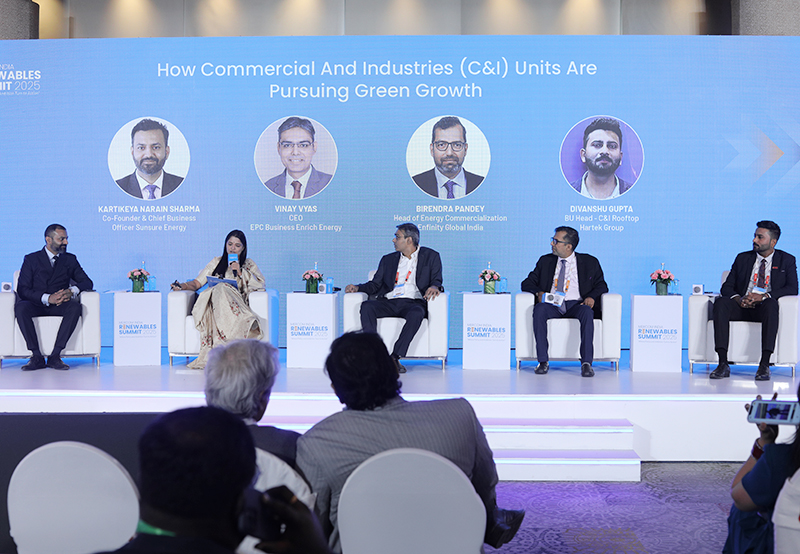Data Centers to Become Largest Consumers of Renewable Energy
Demand from data centers will surpass that of the steel industry
July 28, 2025
Follow Mercom India on WhatsApp for exclusive updates on clean energy news and insights
With the growing demand for power from data centers in the country, project developers are increasingly recognizing battery energy storage systems (BESS) as a vital component of renewable energy projects in the coming years.
At a discussion on “How Industries and Commercial (C&I) Units Are Pursuing Green Growth” held at the Mercom India Renewables Summit 2025 on July 25, 2025, panelists shared their insights on how AI and data centers will drive demand for renewables. They also forecast that the demand for renewable energy from the C&I sector will keep increasing.
The panelists were Kartikeya Narain Sharma, Co-Founder and Chief Business Officer at Sunsure Energy; Vinay Vyas, CEO (EPC Business) at Enrich Energy; Birendra Pandey, Head at Energy Commercialization at Enfinity Global India; and Divanshu Gupta, BU Head at Hartek Group.
Priya Sanjay, Managing Director, Mercom India, moderated the session.
Vinay Vyas said that 56% of the electricity requirement comes from the C&I segment. The rooftop solar segment accounts for more than 65% of the demand from this segment.
Kartikeya Sharma said that the Ministry of Power had requested states to focus on reducing daytime pricing. Such a move will encourage more project developers to opt for hybrid power projects.
“As more solar is injected into the grid, the daytime pricing will get dampened, and people will move away from banking. We (the company) have moved entirely to hybrid solutions. Except for states with no wind potential, we are considering wind-solar hybrid projects. Our interstate transmission system (ISTS) projects will also be wind-solar hybrid projects,” he said.
Rising Demand from Data Centers
The panelists said demand from data centers would require substantial amounts of renewable energy, especially in states like Tamil Nadu, Maharashtra, and Telangana.
Birendra Pandey said most data centers funded by international investors are required to reduce their carbon footprint. “Before they plan their infrastructure for data centers, they also plan their renewable energy footprint. This will be one of the biggest drivers of demand for renewable energy from data centers.”
The demand from data centers is expected to surpass that of the steel industry. They will be the country’s largest consumers of electricity.
Sharma said the need for data center localization drove the first wave of data centers in India. The next wave will come from AI and the proliferation of the internet.
He also highlighted the challenge of supplying power to these data centers. “Unlike typical C&I customers with a running load, data centers have a ramping upload. Every three months, they will add 5 MW, which translates to at least 10 MW of renewable energy. When you work with data centers, you need to have a running pipeline of power projects to sell power in the short term while waiting for the data centers to ramp up their power.”
He said policy uncertainty can make it difficult for renewable power project developers to operate pipeline projects to meet the demand from data centers.
Sharma said solar developers are increasingly moving away from plain wind-solar projects. “Given the contracted BESS capacity of 40 GWh, only a few of that capacity has become operational. It’s only a matter of 18-24 months, when you see 25 GWh of BESS in operation across different modes—states, interstate transmission networks, and behind-the-meter projects.”
Coupled with the states’ need to reduce daytime pricing, Sharma said BESS had found a niche to make BESS commercially viable.
Divanshu Gupta talked about demand from power-intensive industries such as steel and textiles in Punjab. He said these companies were shifting to solar energy and were demanding energy storage too. “Consumers are asking us to build 50 MW projects with a minimum of 5-10 MW of energy storage. Companies don’t want to bank their power with distribution companies (DISCOMs) or an additional 20% course in their nighttime.”
He added that companies in Punjab are also choosing off-site captive power projects.
The panelists focused on the inclusion of more aggregators of containerized battery storage solutions in the market, along with ramping up capacities. This will enable operational efficiency and reduce costs.
Gupta spoke about the growing awareness of renewable energy among C&I consumers. They had realized that behind-the-meter projects are more viable.
“Recently, we commissioned an 8 MW project for Coca-Cola in Jammu and Kashmir, and they were not connected to the grid. To assist our customers, we have added energy storage. The stored energy would meet the power needed for construction and would also provide self-reliance to the consumer after construction,” he added.
Gutpa said even the residential sector had come to understand the futility of relying on banking power and the benefits of storing energy and utilizing it.
Slow Adoption of VVPAs
As a differentiator in the market, Vyas added that his company was providing firm power for particular time slots. Virtual power purchase agreements (VPPA) were also gaining traction.
Pandey said that multiple multinational offtakers have shown interest in VPPAs.
“Earlier, there were companies like Amazon that worked out a strike price for green attributes, and the brown power was sold at the exchange. Now, we see a policy coming in for VPPA. It’s still new, and the policy must be understood. However, some large VPPA deals have already been concluded, and in the future, multinationals will have greater confidence in Indian power project developers’ ability to consistently deliver VPPAs. This will also mature the power trading market, and developers would show more risk in trading,” he said.
Sharma added that sleeved PPAs, popular in European and U.S. markets, are set to enter the Indian power market. “For on-time delivery of power, we develop short-term power projects before we supply the long-term power projects. In this case, the customer wants to ensure power delivery but is willing to cover the costs until the power comes online.”
